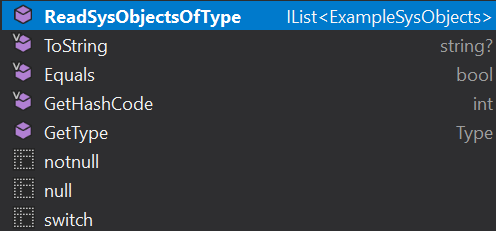Getting Started
The CA.Blocks.DataAccess have been published to NuGet. First thing that you need to decide is which provider we want to use.
For SQL server https://www.nuget.org/packages/CA.Blocks.SQLServerDataAccess/
PM> Install-Package CA.Blocks.SQLServerDataAccess -Version x.x.x.
For SQL Microsoft.Data.Sqlite https://www.nuget.org/packages/CA.Blocks.SQLLiteDataAccess/
PM> Install-Package CA.Blocks.SQLLiteDataAccess -Version x.x.x
The second thing you need to do is setup a connection string see Connection String Examples
Then you will be ready to work with the DataAccess Class
Template example accessing SQL server
In this example we going to use the data from the local SQL server selecting the data from the sysobjects table and executing the results into the .NET class ExampleSysObjects below
public class ExampleSysObjects
{
public int Id { get; set; }
public string Name { get; set; }
public string XType { get; set; }
public DateTime CreateDate { get; set; }
}Template code using SQL server.
public class ExampleReadDataAsExecuteListOf : SqlServerDataAccess
{
public ExampleReadDataAsExecuteListOf() : base(
new DataAccessConfig("SampleConfig", new DataAccessConfigOptions { ConnectionStringKey = "notused" },
new HardCodedConnectionStringsResolver("Server=(localdb)\\MSSQLLocalDB;Integrated Security = true"))
)
{
}
public IList<ExampleSysObjects> ReadSysObjectsOfType(string xtype)
{
var cmd = CreateTextCommand("Select top 10 id as Id, name as Name, xtype as XType, crdate as CreateDate from sysobjects where xtype = @xtype").WithParameter(xtype.ToSqlParameter("@xtype"));
return ExecuteToListOf<ExampleSysObjects>(cmd);
}
}Notes:
- The Class inherits from SqlServerDataAccess which is the SQL server provider.
- The example above is using the provided HardCodedConnectionStringsResolver, this is provided for quick prototyping, samples and testing code allowing connection to be specified in line with the code. It is recommended you use an external connection string when working on something that is to be published. see Connection String Examples
- The ReadSysObjectsOfType method represents your DataAccess Method, the only input parameter exposed is xtype, and return type will be a IList of ExampleSysObjects
- The CreateTextCommand will return a Interface to the SQL server implementation of the command
- The SQL is constructed internally as parameterized query this is a developer responsibility
- The conversion of .NET string to SQL parameter is done in .WithParameter(xtype.ToSqlParameter("@xtype")); you can also use the connection object directly ie cmd.Parameters.Add(xtype.ToSqlParameter("@xtype"));
- The ToSqlParameter is a convention to taking a .NET type into a SQL server parameter. All .NET value types will have implementations of ToSqlParameter();
- The cmd is then passed into the ExecuteToListOf method which returns the data as a IList of ExampleSysObjects. As we have 1-1 mapping the conversion is handled 100% by the Blocks.
Consuming this class:
[Test]
public void ExecuteToListOfDev()
{
var target = new ExampleReadDataAsExecuteListOf();
var executeResult = target.ReadSysObjectsOfType("U");
foreach (var o in executeResult)
{
TestContext.WriteLine($"{o.Id},{o.Name},{o.XType},{o.CreateDate}");
}
}Notes:
- You construct the instance of the DataAccess ExampleReadDataAsExecuteListOf()
- You Call the method ReadSysObjectsOfType("U") The only methods you see are public ones from System.Object and the ReadSysObjectsOfType. This is by design the guts of the DataAccess class is protected By default. The Instance of the DataAccess can access the method, but the calling client only sees what is exposed. The calling code cannot call ExecuteToListOf

The dump result
-463397375,trace_xe_action_map,U ,30/04/2016 12:44:47 AM
-319884821,trace_xe_event_map,U ,30/04/2016 12:44:46 AM
117575457,spt_fallback_db,U ,8/04/2003 9:18:01 AM
133575514,spt_fallback_dev,U ,8/04/2003 9:18:02 AM
149575571,spt_fallback_usg,U ,8/04/2003 9:18:04 AM
1483152329,spt_monitor,U ,30/04/2016 12:46:37 AM
1787153412,MSreplication_options,U ,30/04/2016 12:47:59 AM